Corporate Takeover Decision and Consolidation Accounting Report
VerifiedAdded on 2022/11/13
|13
|3718
|320
Report
AI Summary
This report provides an executive summary and in-depth analysis of corporate and financial accounting principles, specifically focusing on AASB standards and their application to business combinations, intragroup transactions, and non-controlling interests. The report delves into the differences between equity accounting and consolidation accounting, examining the implications of AASB 128 Investments in Associates and AASB 3 Business Combinations. It explains the treatment of intragroup transactions according to AASB 127 Consolidated and Separate Financial Statements and AASB 10 Consolidated Financial Statements, and discusses the influence of disclosure requirements for non-controlling interests. The report includes practical examples, such as the consolidation of financial statements and the calculation of non-controlling interests in subsidiary profits. It also references relevant accounting standards and provides a comprehensive understanding of the key concepts.

Running head: Corporate and Financial Accounting
Corporate and Financial Accounting
Corporate and Financial Accounting
Paraphrase This Document
Need a fresh take? Get an instant paraphrase of this document with our AI Paraphraser
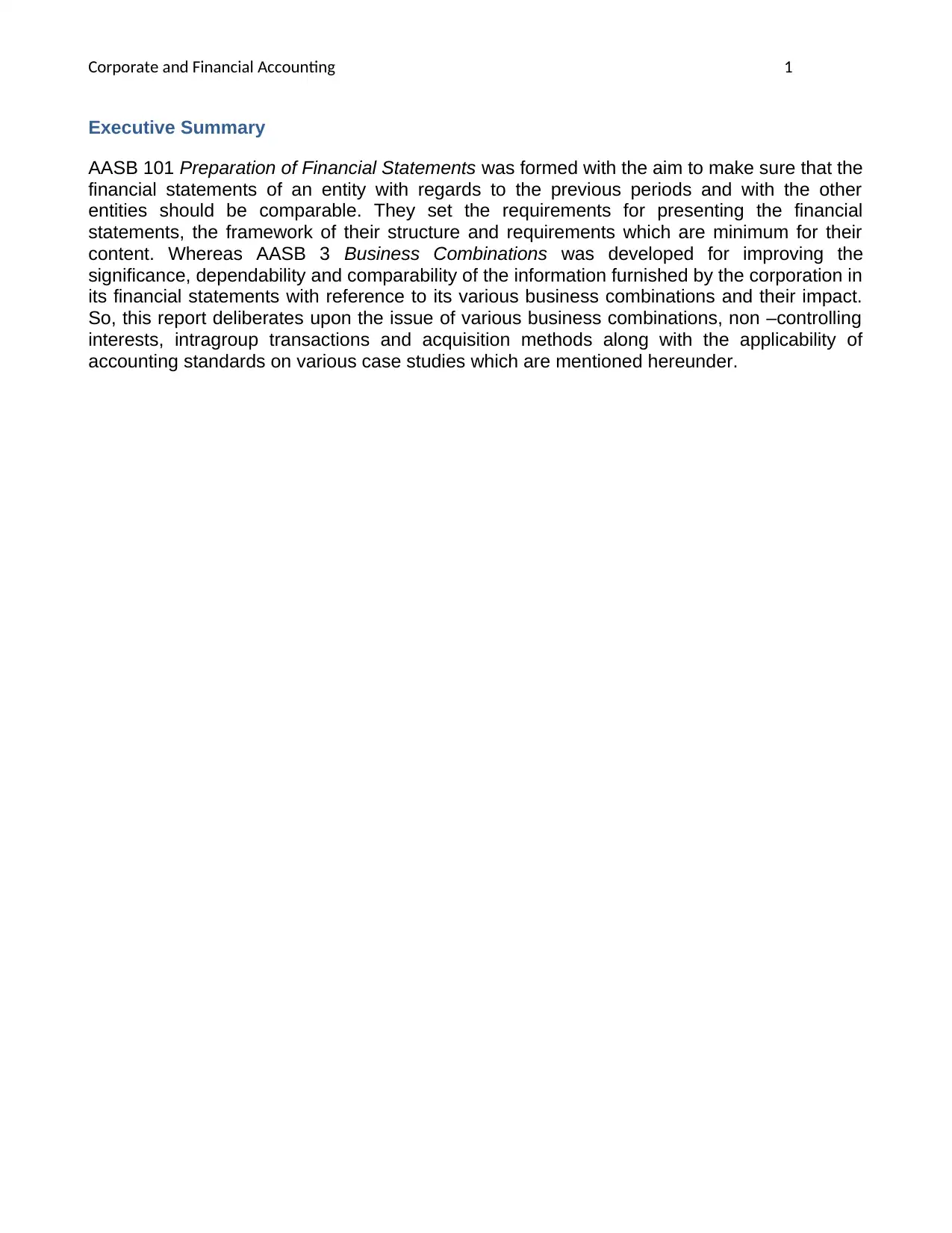
Corporate and Financial Accounting 1
Executive Summary
AASB 101 Preparation of Financial Statements was formed with the aim to make sure that the
financial statements of an entity with regards to the previous periods and with the other
entities should be comparable. They set the requirements for presenting the financial
statements, the framework of their structure and requirements which are minimum for their
content. Whereas AASB 3 Business Combinations was developed for improving the
significance, dependability and comparability of the information furnished by the corporation in
its financial statements with reference to its various business combinations and their impact.
So, this report deliberates upon the issue of various business combinations, non –controlling
interests, intragroup transactions and acquisition methods along with the applicability of
accounting standards on various case studies which are mentioned hereunder.
Executive Summary
AASB 101 Preparation of Financial Statements was formed with the aim to make sure that the
financial statements of an entity with regards to the previous periods and with the other
entities should be comparable. They set the requirements for presenting the financial
statements, the framework of their structure and requirements which are minimum for their
content. Whereas AASB 3 Business Combinations was developed for improving the
significance, dependability and comparability of the information furnished by the corporation in
its financial statements with reference to its various business combinations and their impact.
So, this report deliberates upon the issue of various business combinations, non –controlling
interests, intragroup transactions and acquisition methods along with the applicability of
accounting standards on various case studies which are mentioned hereunder.
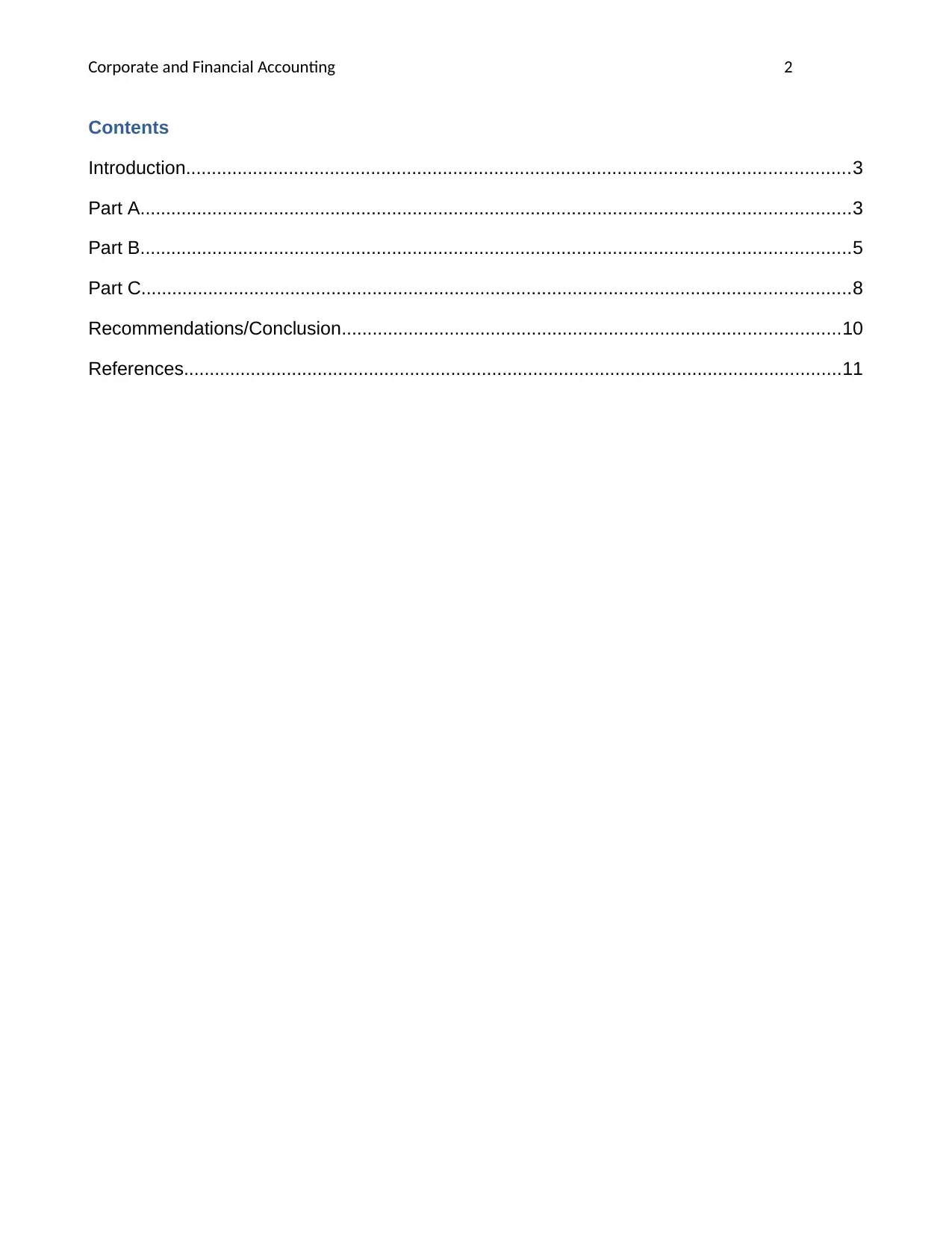
Corporate and Financial Accounting 2
Contents
Introduction.................................................................................................................................3
Part A..........................................................................................................................................3
Part B..........................................................................................................................................5
Part C..........................................................................................................................................8
Recommendations/Conclusion.................................................................................................10
References................................................................................................................................11
Contents
Introduction.................................................................................................................................3
Part A..........................................................................................................................................3
Part B..........................................................................................................................................5
Part C..........................................................................................................................................8
Recommendations/Conclusion.................................................................................................10
References................................................................................................................................11
⊘ This is a preview!⊘
Do you want full access?
Subscribe today to unlock all pages.

Trusted by 1+ million students worldwide
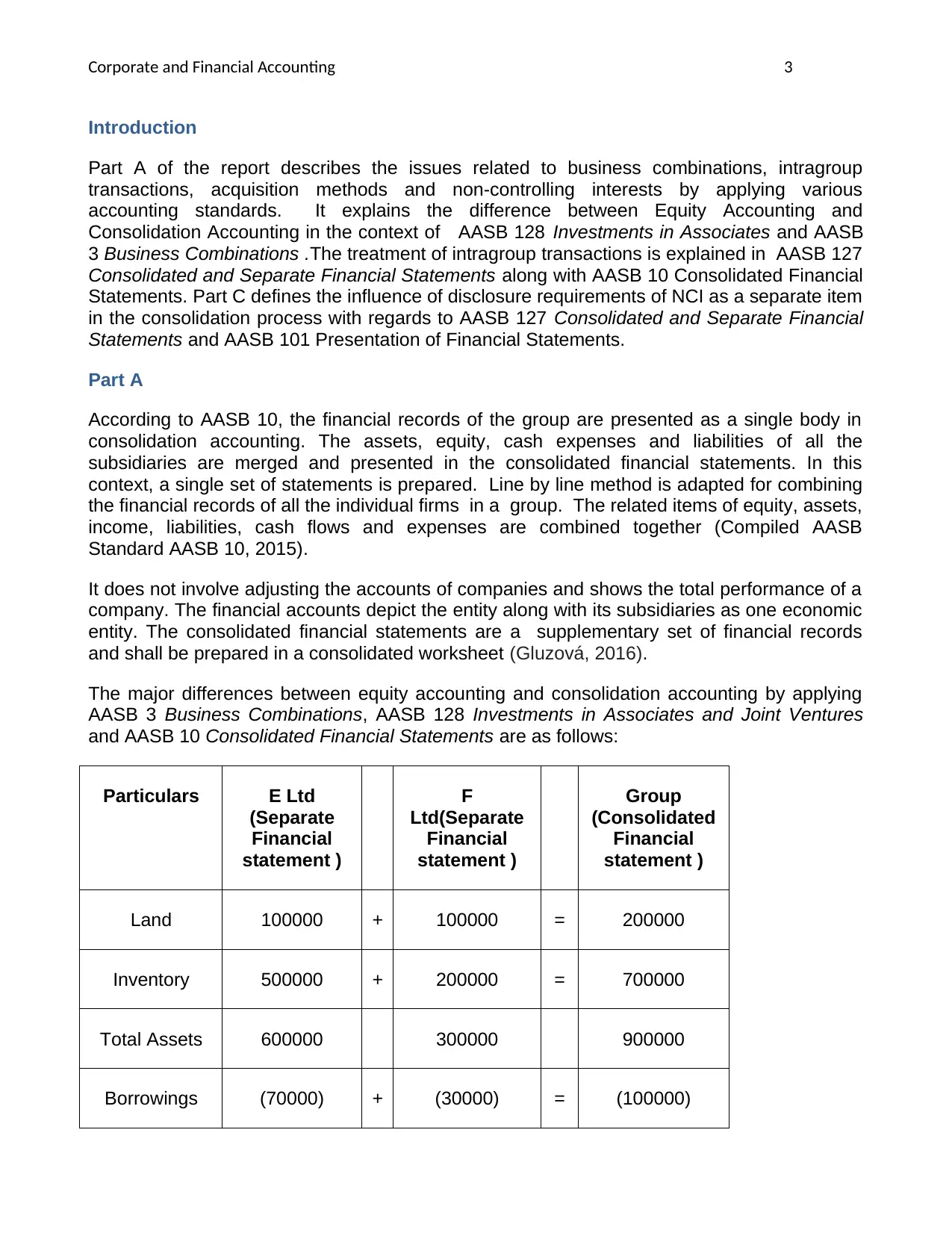
Corporate and Financial Accounting 3
Introduction
Part A of the report describes the issues related to business combinations, intragroup
transactions, acquisition methods and non-controlling interests by applying various
accounting standards. It explains the difference between Equity Accounting and
Consolidation Accounting in the context of AASB 128 Investments in Associates and AASB
3 Business Combinations .The treatment of intragroup transactions is explained in AASB 127
Consolidated and Separate Financial Statements along with AASB 10 Consolidated Financial
Statements. Part C defines the influence of disclosure requirements of NCI as a separate item
in the consolidation process with regards to AASB 127 Consolidated and Separate Financial
Statements and AASB 101 Presentation of Financial Statements.
Part A
According to AASB 10, the financial records of the group are presented as a single body in
consolidation accounting. The assets, equity, cash expenses and liabilities of all the
subsidiaries are merged and presented in the consolidated financial statements. In this
context, a single set of statements is prepared. Line by line method is adapted for combining
the financial records of all the individual firms in a group. The related items of equity, assets,
income, liabilities, cash flows and expenses are combined together (Compiled AASB
Standard AASB 10, 2015).
It does not involve adjusting the accounts of companies and shows the total performance of a
company. The financial accounts depict the entity along with its subsidiaries as one economic
entity. The consolidated financial statements are a supplementary set of financial records
and shall be prepared in a consolidated worksheet (Gluzová, 2016).
The major differences between equity accounting and consolidation accounting by applying
AASB 3 Business Combinations, AASB 128 Investments in Associates and Joint Ventures
and AASB 10 Consolidated Financial Statements are as follows:
Particulars E Ltd
(Separate
Financial
statement )
F
Ltd(Separate
Financial
statement )
Group
(Consolidated
Financial
statement )
Land 100000 + 100000 = 200000
Inventory 500000 + 200000 = 700000
Total Assets 600000 300000 900000
Borrowings (70000) + (30000) = (100000)
Introduction
Part A of the report describes the issues related to business combinations, intragroup
transactions, acquisition methods and non-controlling interests by applying various
accounting standards. It explains the difference between Equity Accounting and
Consolidation Accounting in the context of AASB 128 Investments in Associates and AASB
3 Business Combinations .The treatment of intragroup transactions is explained in AASB 127
Consolidated and Separate Financial Statements along with AASB 10 Consolidated Financial
Statements. Part C defines the influence of disclosure requirements of NCI as a separate item
in the consolidation process with regards to AASB 127 Consolidated and Separate Financial
Statements and AASB 101 Presentation of Financial Statements.
Part A
According to AASB 10, the financial records of the group are presented as a single body in
consolidation accounting. The assets, equity, cash expenses and liabilities of all the
subsidiaries are merged and presented in the consolidated financial statements. In this
context, a single set of statements is prepared. Line by line method is adapted for combining
the financial records of all the individual firms in a group. The related items of equity, assets,
income, liabilities, cash flows and expenses are combined together (Compiled AASB
Standard AASB 10, 2015).
It does not involve adjusting the accounts of companies and shows the total performance of a
company. The financial accounts depict the entity along with its subsidiaries as one economic
entity. The consolidated financial statements are a supplementary set of financial records
and shall be prepared in a consolidated worksheet (Gluzová, 2016).
The major differences between equity accounting and consolidation accounting by applying
AASB 3 Business Combinations, AASB 128 Investments in Associates and Joint Ventures
and AASB 10 Consolidated Financial Statements are as follows:
Particulars E Ltd
(Separate
Financial
statement )
F
Ltd(Separate
Financial
statement )
Group
(Consolidated
Financial
statement )
Land 100000 + 100000 = 200000
Inventory 500000 + 200000 = 700000
Total Assets 600000 300000 900000
Borrowings (70000) + (30000) = (100000)
Paraphrase This Document
Need a fresh take? Get an instant paraphrase of this document with our AI Paraphraser
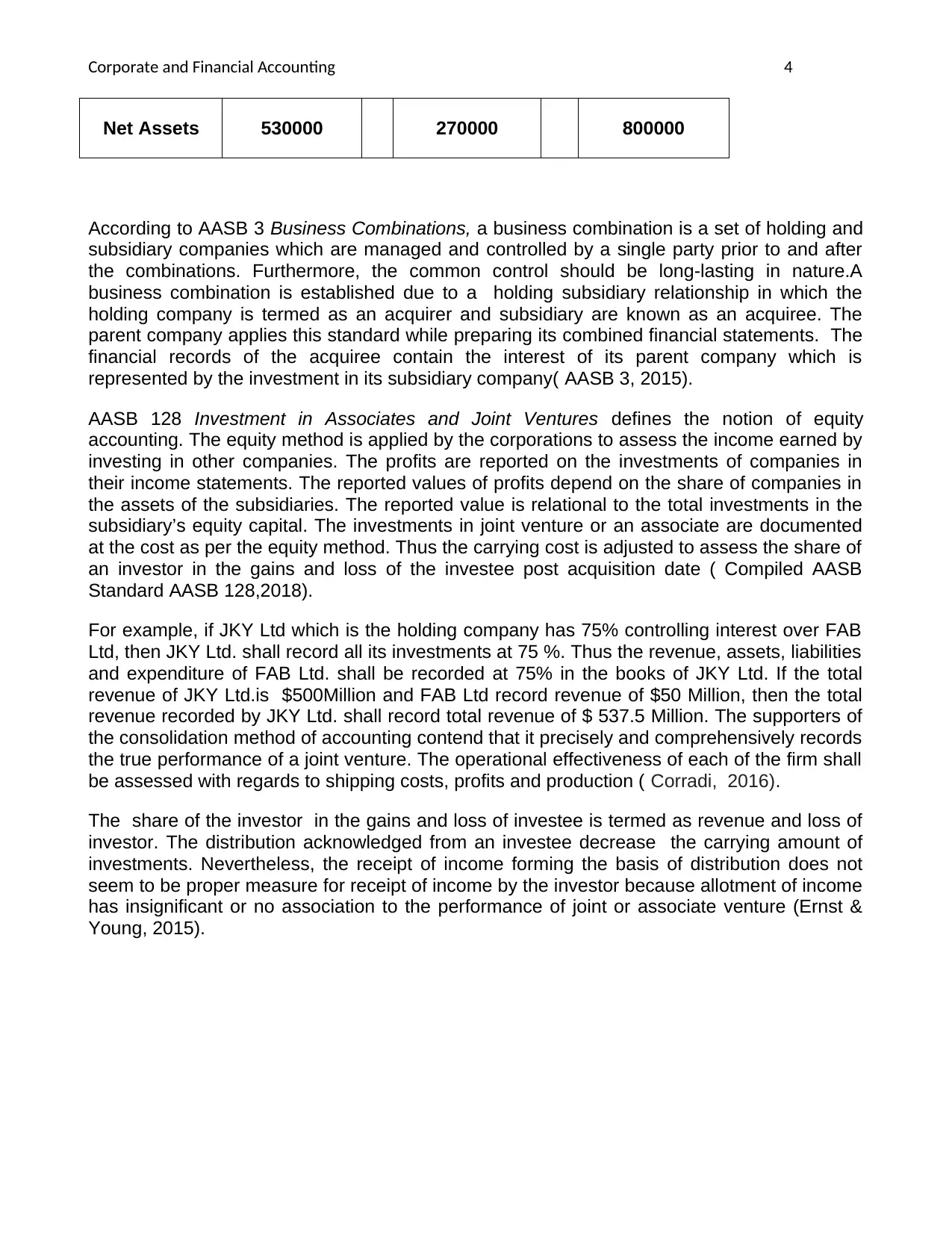
Corporate and Financial Accounting 4
Net Assets 530000 270000 800000
According to AASB 3 Business Combinations, a business combination is a set of holding and
subsidiary companies which are managed and controlled by a single party prior to and after
the combinations. Furthermore, the common control should be long-lasting in nature.A
business combination is established due to a holding subsidiary relationship in which the
holding company is termed as an acquirer and subsidiary are known as an acquiree. The
parent company applies this standard while preparing its combined financial statements. The
financial records of the acquiree contain the interest of its parent company which is
represented by the investment in its subsidiary company( AASB 3, 2015).
AASB 128 Investment in Associates and Joint Ventures defines the notion of equity
accounting. The equity method is applied by the corporations to assess the income earned by
investing in other companies. The profits are reported on the investments of companies in
their income statements. The reported values of profits depend on the share of companies in
the assets of the subsidiaries. The reported value is relational to the total investments in the
subsidiary’s equity capital. The investments in joint venture or an associate are documented
at the cost as per the equity method. Thus the carrying cost is adjusted to assess the share of
an investor in the gains and loss of the investee post acquisition date ( Compiled AASB
Standard AASB 128,2018).
For example, if JKY Ltd which is the holding company has 75% controlling interest over FAB
Ltd, then JKY Ltd. shall record all its investments at 75 %. Thus the revenue, assets, liabilities
and expenditure of FAB Ltd. shall be recorded at 75% in the books of JKY Ltd. If the total
revenue of JKY Ltd.is $500Million and FAB Ltd record revenue of $50 Million, then the total
revenue recorded by JKY Ltd. shall record total revenue of $ 537.5 Million. The supporters of
the consolidation method of accounting contend that it precisely and comprehensively records
the true performance of a joint venture. The operational effectiveness of each of the firm shall
be assessed with regards to shipping costs, profits and production ( Corradi, 2016).
The share of the investor in the gains and loss of investee is termed as revenue and loss of
investor. The distribution acknowledged from an investee decrease the carrying amount of
investments. Nevertheless, the receipt of income forming the basis of distribution does not
seem to be proper measure for receipt of income by the investor because allotment of income
has insignificant or no association to the performance of joint or associate venture (Ernst &
Young, 2015).
Net Assets 530000 270000 800000
According to AASB 3 Business Combinations, a business combination is a set of holding and
subsidiary companies which are managed and controlled by a single party prior to and after
the combinations. Furthermore, the common control should be long-lasting in nature.A
business combination is established due to a holding subsidiary relationship in which the
holding company is termed as an acquirer and subsidiary are known as an acquiree. The
parent company applies this standard while preparing its combined financial statements. The
financial records of the acquiree contain the interest of its parent company which is
represented by the investment in its subsidiary company( AASB 3, 2015).
AASB 128 Investment in Associates and Joint Ventures defines the notion of equity
accounting. The equity method is applied by the corporations to assess the income earned by
investing in other companies. The profits are reported on the investments of companies in
their income statements. The reported values of profits depend on the share of companies in
the assets of the subsidiaries. The reported value is relational to the total investments in the
subsidiary’s equity capital. The investments in joint venture or an associate are documented
at the cost as per the equity method. Thus the carrying cost is adjusted to assess the share of
an investor in the gains and loss of the investee post acquisition date ( Compiled AASB
Standard AASB 128,2018).
For example, if JKY Ltd which is the holding company has 75% controlling interest over FAB
Ltd, then JKY Ltd. shall record all its investments at 75 %. Thus the revenue, assets, liabilities
and expenditure of FAB Ltd. shall be recorded at 75% in the books of JKY Ltd. If the total
revenue of JKY Ltd.is $500Million and FAB Ltd record revenue of $50 Million, then the total
revenue recorded by JKY Ltd. shall record total revenue of $ 537.5 Million. The supporters of
the consolidation method of accounting contend that it precisely and comprehensively records
the true performance of a joint venture. The operational effectiveness of each of the firm shall
be assessed with regards to shipping costs, profits and production ( Corradi, 2016).
The share of the investor in the gains and loss of investee is termed as revenue and loss of
investor. The distribution acknowledged from an investee decrease the carrying amount of
investments. Nevertheless, the receipt of income forming the basis of distribution does not
seem to be proper measure for receipt of income by the investor because allotment of income
has insignificant or no association to the performance of joint or associate venture (Ernst &
Young, 2015).
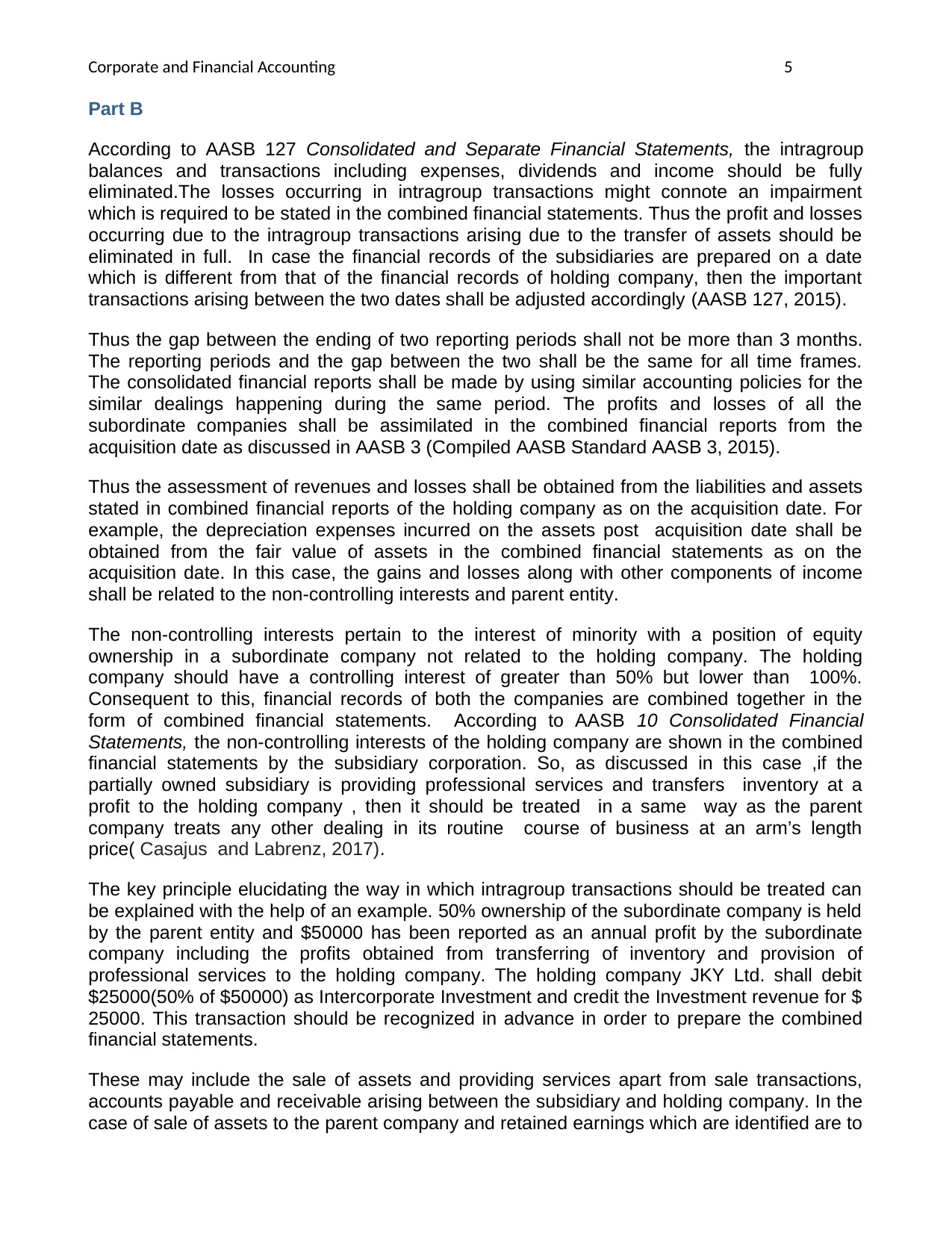
Corporate and Financial Accounting 5
Part B
According to AASB 127 Consolidated and Separate Financial Statements, the intragroup
balances and transactions including expenses, dividends and income should be fully
eliminated.The losses occurring in intragroup transactions might connote an impairment
which is required to be stated in the combined financial statements. Thus the profit and losses
occurring due to the intragroup transactions arising due to the transfer of assets should be
eliminated in full. In case the financial records of the subsidiaries are prepared on a date
which is different from that of the financial records of holding company, then the important
transactions arising between the two dates shall be adjusted accordingly (AASB 127, 2015).
Thus the gap between the ending of two reporting periods shall not be more than 3 months.
The reporting periods and the gap between the two shall be the same for all time frames.
The consolidated financial reports shall be made by using similar accounting policies for the
similar dealings happening during the same period. The profits and losses of all the
subordinate companies shall be assimilated in the combined financial reports from the
acquisition date as discussed in AASB 3 (Compiled AASB Standard AASB 3, 2015).
Thus the assessment of revenues and losses shall be obtained from the liabilities and assets
stated in combined financial reports of the holding company as on the acquisition date. For
example, the depreciation expenses incurred on the assets post acquisition date shall be
obtained from the fair value of assets in the combined financial statements as on the
acquisition date. In this case, the gains and losses along with other components of income
shall be related to the non-controlling interests and parent entity.
The non-controlling interests pertain to the interest of minority with a position of equity
ownership in a subordinate company not related to the holding company. The holding
company should have a controlling interest of greater than 50% but lower than 100%.
Consequent to this, financial records of both the companies are combined together in the
form of combined financial statements. According to AASB 10 Consolidated Financial
Statements, the non-controlling interests of the holding company are shown in the combined
financial statements by the subsidiary corporation. So, as discussed in this case ,if the
partially owned subsidiary is providing professional services and transfers inventory at a
profit to the holding company , then it should be treated in a same way as the parent
company treats any other dealing in its routine course of business at an arm’s length
price( Casajus and Labrenz, 2017).
The key principle elucidating the way in which intragroup transactions should be treated can
be explained with the help of an example. 50% ownership of the subordinate company is held
by the parent entity and $50000 has been reported as an annual profit by the subordinate
company including the profits obtained from transferring of inventory and provision of
professional services to the holding company. The holding company JKY Ltd. shall debit
$25000(50% of $50000) as Intercorporate Investment and credit the Investment revenue for $
25000. This transaction should be recognized in advance in order to prepare the combined
financial statements.
These may include the sale of assets and providing services apart from sale transactions,
accounts payable and receivable arising between the subsidiary and holding company. In the
case of sale of assets to the parent company and retained earnings which are identified are to
Part B
According to AASB 127 Consolidated and Separate Financial Statements, the intragroup
balances and transactions including expenses, dividends and income should be fully
eliminated.The losses occurring in intragroup transactions might connote an impairment
which is required to be stated in the combined financial statements. Thus the profit and losses
occurring due to the intragroup transactions arising due to the transfer of assets should be
eliminated in full. In case the financial records of the subsidiaries are prepared on a date
which is different from that of the financial records of holding company, then the important
transactions arising between the two dates shall be adjusted accordingly (AASB 127, 2015).
Thus the gap between the ending of two reporting periods shall not be more than 3 months.
The reporting periods and the gap between the two shall be the same for all time frames.
The consolidated financial reports shall be made by using similar accounting policies for the
similar dealings happening during the same period. The profits and losses of all the
subordinate companies shall be assimilated in the combined financial reports from the
acquisition date as discussed in AASB 3 (Compiled AASB Standard AASB 3, 2015).
Thus the assessment of revenues and losses shall be obtained from the liabilities and assets
stated in combined financial reports of the holding company as on the acquisition date. For
example, the depreciation expenses incurred on the assets post acquisition date shall be
obtained from the fair value of assets in the combined financial statements as on the
acquisition date. In this case, the gains and losses along with other components of income
shall be related to the non-controlling interests and parent entity.
The non-controlling interests pertain to the interest of minority with a position of equity
ownership in a subordinate company not related to the holding company. The holding
company should have a controlling interest of greater than 50% but lower than 100%.
Consequent to this, financial records of both the companies are combined together in the
form of combined financial statements. According to AASB 10 Consolidated Financial
Statements, the non-controlling interests of the holding company are shown in the combined
financial statements by the subsidiary corporation. So, as discussed in this case ,if the
partially owned subsidiary is providing professional services and transfers inventory at a
profit to the holding company , then it should be treated in a same way as the parent
company treats any other dealing in its routine course of business at an arm’s length
price( Casajus and Labrenz, 2017).
The key principle elucidating the way in which intragroup transactions should be treated can
be explained with the help of an example. 50% ownership of the subordinate company is held
by the parent entity and $50000 has been reported as an annual profit by the subordinate
company including the profits obtained from transferring of inventory and provision of
professional services to the holding company. The holding company JKY Ltd. shall debit
$25000(50% of $50000) as Intercorporate Investment and credit the Investment revenue for $
25000. This transaction should be recognized in advance in order to prepare the combined
financial statements.
These may include the sale of assets and providing services apart from sale transactions,
accounts payable and receivable arising between the subsidiary and holding company. In the
case of sale of assets to the parent company and retained earnings which are identified are to
⊘ This is a preview!⊘
Do you want full access?
Subscribe today to unlock all pages.

Trusted by 1+ million students worldwide
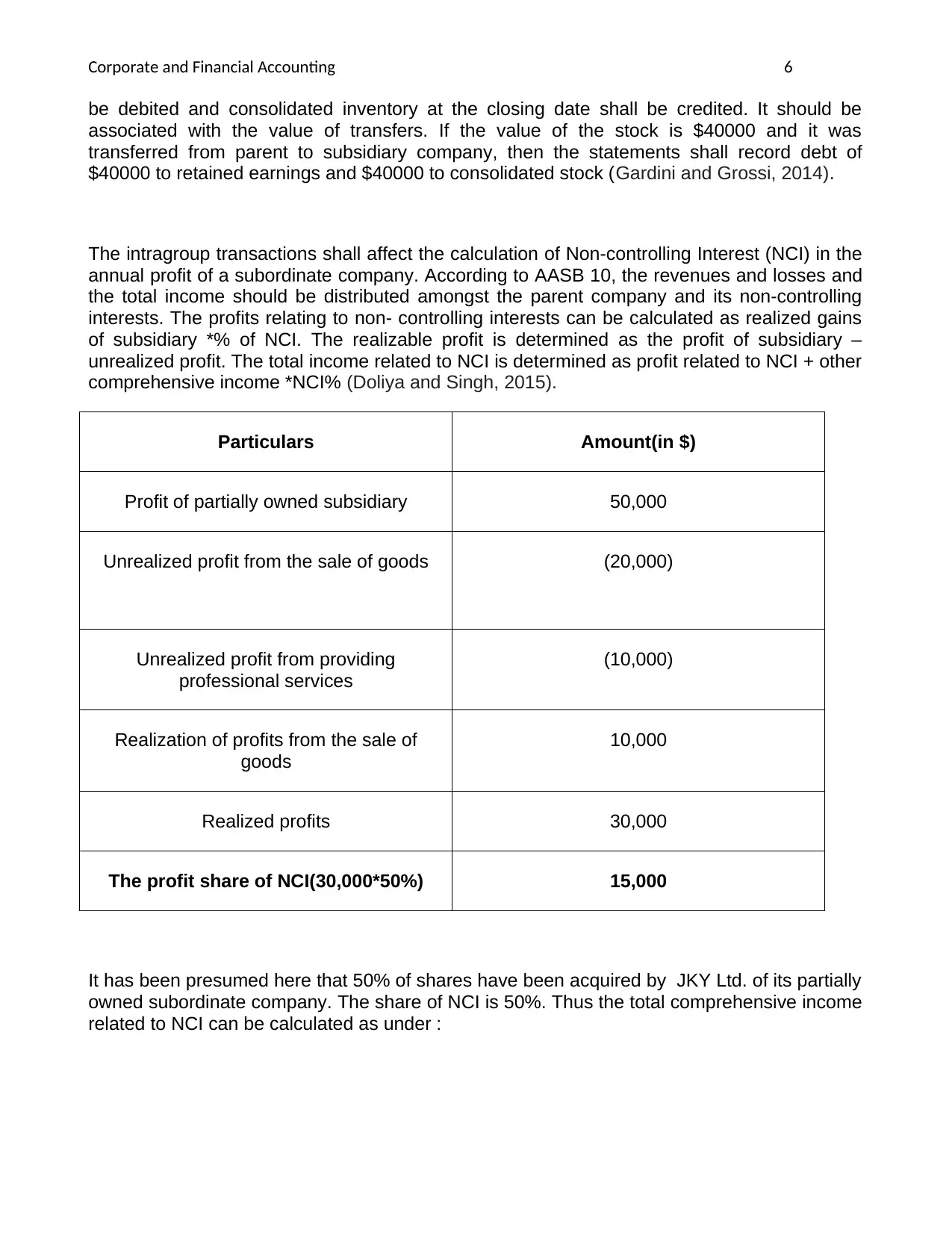
Corporate and Financial Accounting 6
be debited and consolidated inventory at the closing date shall be credited. It should be
associated with the value of transfers. If the value of the stock is $40000 and it was
transferred from parent to subsidiary company, then the statements shall record debt of
$40000 to retained earnings and $40000 to consolidated stock (Gardini and Grossi, 2014).
The intragroup transactions shall affect the calculation of Non-controlling Interest (NCI) in the
annual profit of a subordinate company. According to AASB 10, the revenues and losses and
the total income should be distributed amongst the parent company and its non-controlling
interests. The profits relating to non- controlling interests can be calculated as realized gains
of subsidiary *% of NCI. The realizable profit is determined as the profit of subsidiary –
unrealized profit. The total income related to NCI is determined as profit related to NCI + other
comprehensive income *NCI% (Doliya and Singh, 2015).
Particulars Amount(in $)
Profit of partially owned subsidiary 50,000
Unrealized profit from the sale of goods (20,000)
Unrealized profit from providing
professional services
(10,000)
Realization of profits from the sale of
goods
10,000
Realized profits 30,000
The profit share of NCI(30,000*50%) 15,000
It has been presumed here that 50% of shares have been acquired by JKY Ltd. of its partially
owned subordinate company. The share of NCI is 50%. Thus the total comprehensive income
related to NCI can be calculated as under :
be debited and consolidated inventory at the closing date shall be credited. It should be
associated with the value of transfers. If the value of the stock is $40000 and it was
transferred from parent to subsidiary company, then the statements shall record debt of
$40000 to retained earnings and $40000 to consolidated stock (Gardini and Grossi, 2014).
The intragroup transactions shall affect the calculation of Non-controlling Interest (NCI) in the
annual profit of a subordinate company. According to AASB 10, the revenues and losses and
the total income should be distributed amongst the parent company and its non-controlling
interests. The profits relating to non- controlling interests can be calculated as realized gains
of subsidiary *% of NCI. The realizable profit is determined as the profit of subsidiary –
unrealized profit. The total income related to NCI is determined as profit related to NCI + other
comprehensive income *NCI% (Doliya and Singh, 2015).
Particulars Amount(in $)
Profit of partially owned subsidiary 50,000
Unrealized profit from the sale of goods (20,000)
Unrealized profit from providing
professional services
(10,000)
Realization of profits from the sale of
goods
10,000
Realized profits 30,000
The profit share of NCI(30,000*50%) 15,000
It has been presumed here that 50% of shares have been acquired by JKY Ltd. of its partially
owned subordinate company. The share of NCI is 50%. Thus the total comprehensive income
related to NCI can be calculated as under :
Paraphrase This Document
Need a fresh take? Get an instant paraphrase of this document with our AI Paraphraser
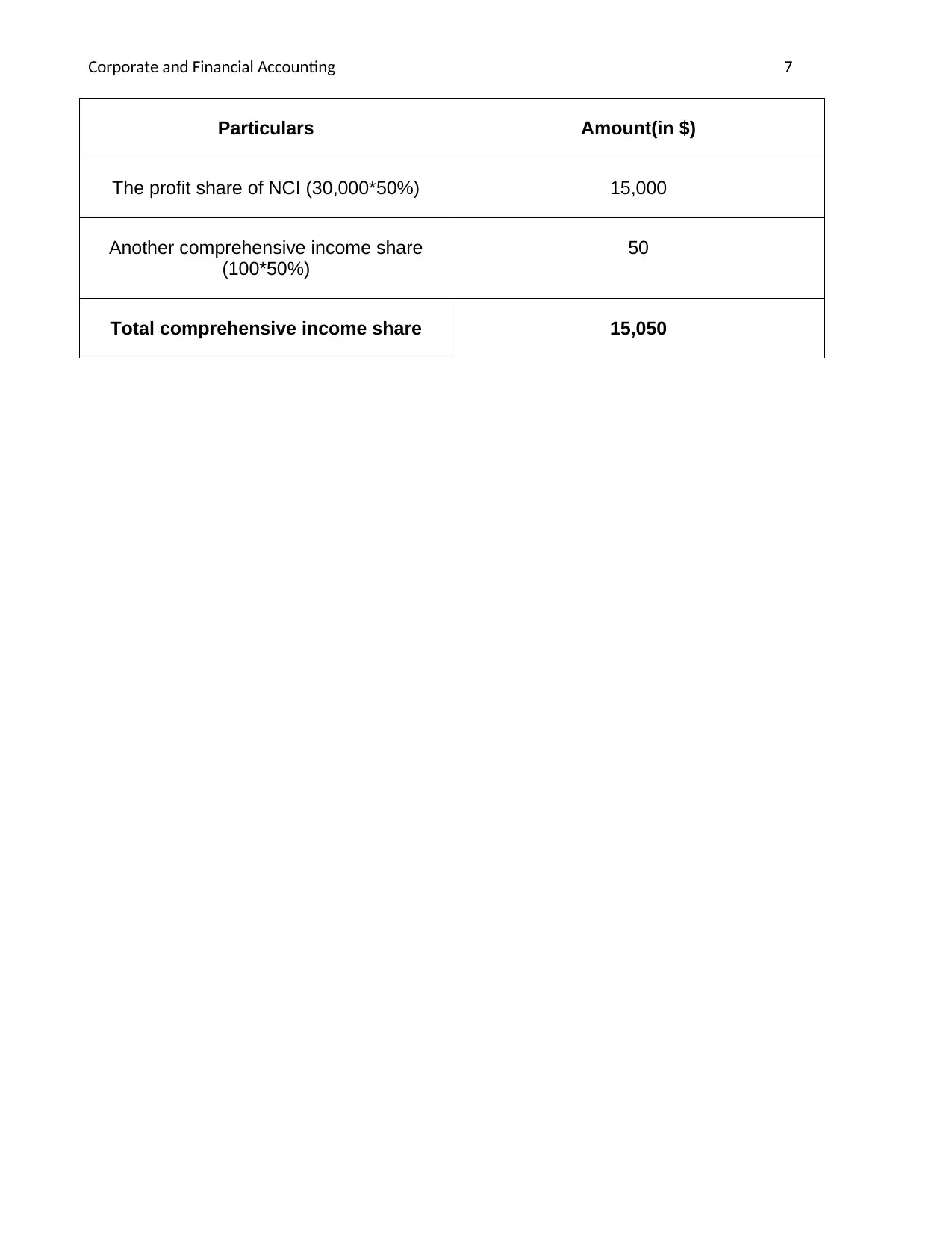
Corporate and Financial Accounting 7
Particulars Amount(in $)
The profit share of NCI (30,000*50%) 15,000
Another comprehensive income share
(100*50%)
50
Total comprehensive income share 15,050
Particulars Amount(in $)
The profit share of NCI (30,000*50%) 15,000
Another comprehensive income share
(100*50%)
50
Total comprehensive income share 15,050
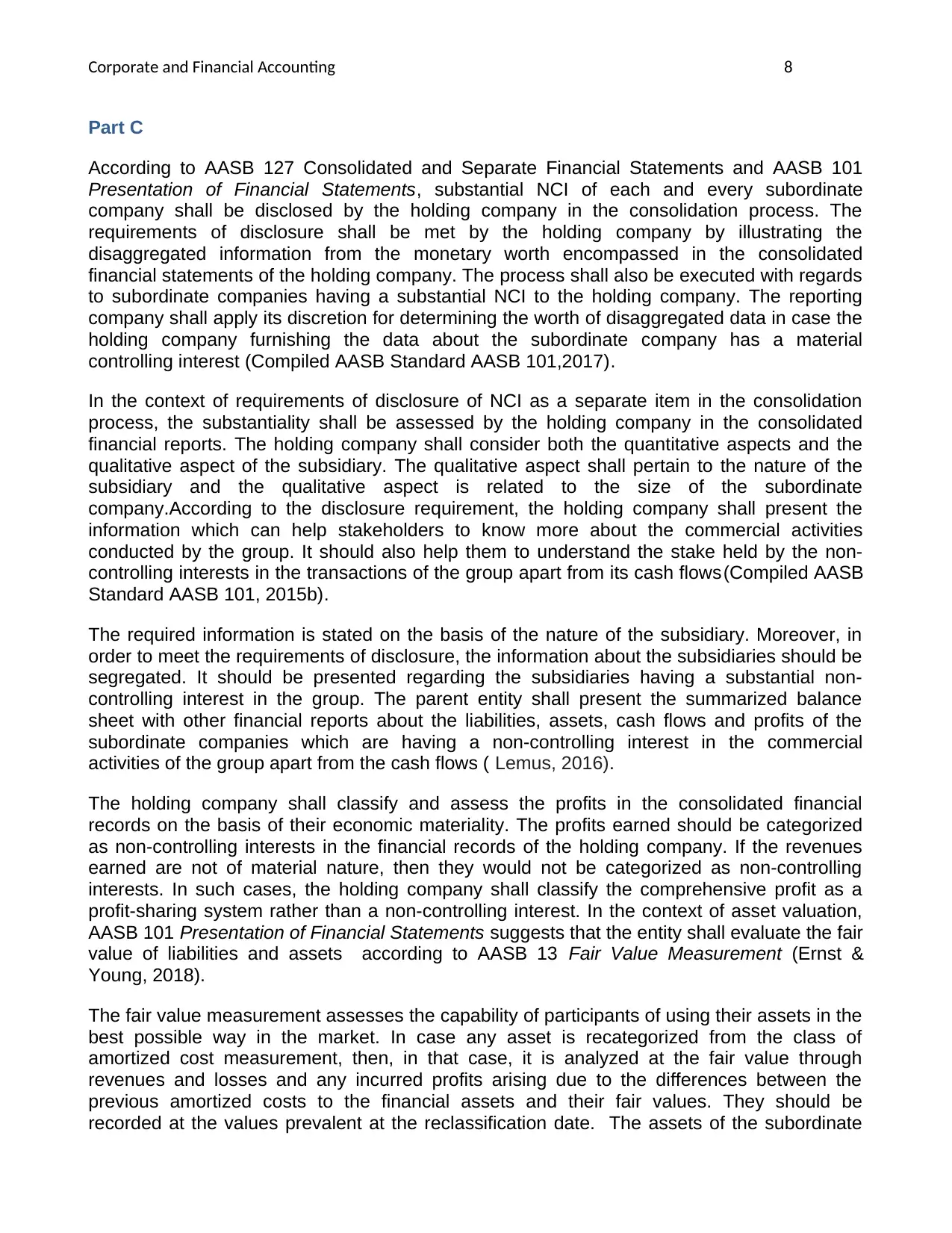
Corporate and Financial Accounting 8
Part C
According to AASB 127 Consolidated and Separate Financial Statements and AASB 101
Presentation of Financial Statements, substantial NCI of each and every subordinate
company shall be disclosed by the holding company in the consolidation process. The
requirements of disclosure shall be met by the holding company by illustrating the
disaggregated information from the monetary worth encompassed in the consolidated
financial statements of the holding company. The process shall also be executed with regards
to subordinate companies having a substantial NCI to the holding company. The reporting
company shall apply its discretion for determining the worth of disaggregated data in case the
holding company furnishing the data about the subordinate company has a material
controlling interest (Compiled AASB Standard AASB 101,2017).
In the context of requirements of disclosure of NCI as a separate item in the consolidation
process, the substantiality shall be assessed by the holding company in the consolidated
financial reports. The holding company shall consider both the quantitative aspects and the
qualitative aspect of the subsidiary. The qualitative aspect shall pertain to the nature of the
subsidiary and the qualitative aspect is related to the size of the subordinate
company.According to the disclosure requirement, the holding company shall present the
information which can help stakeholders to know more about the commercial activities
conducted by the group. It should also help them to understand the stake held by the non-
controlling interests in the transactions of the group apart from its cash flows(Compiled AASB
Standard AASB 101, 2015b).
The required information is stated on the basis of the nature of the subsidiary. Moreover, in
order to meet the requirements of disclosure, the information about the subsidiaries should be
segregated. It should be presented regarding the subsidiaries having a substantial non-
controlling interest in the group. The parent entity shall present the summarized balance
sheet with other financial reports about the liabilities, assets, cash flows and profits of the
subordinate companies which are having a non-controlling interest in the commercial
activities of the group apart from the cash flows ( Lemus, 2016).
The holding company shall classify and assess the profits in the consolidated financial
records on the basis of their economic materiality. The profits earned should be categorized
as non-controlling interests in the financial records of the holding company. If the revenues
earned are not of material nature, then they would not be categorized as non-controlling
interests. In such cases, the holding company shall classify the comprehensive profit as a
profit-sharing system rather than a non-controlling interest. In the context of asset valuation,
AASB 101 Presentation of Financial Statements suggests that the entity shall evaluate the fair
value of liabilities and assets according to AASB 13 Fair Value Measurement (Ernst &
Young, 2018).
The fair value measurement assesses the capability of participants of using their assets in the
best possible way in the market. In case any asset is recategorized from the class of
amortized cost measurement, then, in that case, it is analyzed at the fair value through
revenues and losses and any incurred profits arising due to the differences between the
previous amortized costs to the financial assets and their fair values. They should be
recorded at the values prevalent at the reclassification date. The assets of the subordinate
Part C
According to AASB 127 Consolidated and Separate Financial Statements and AASB 101
Presentation of Financial Statements, substantial NCI of each and every subordinate
company shall be disclosed by the holding company in the consolidation process. The
requirements of disclosure shall be met by the holding company by illustrating the
disaggregated information from the monetary worth encompassed in the consolidated
financial statements of the holding company. The process shall also be executed with regards
to subordinate companies having a substantial NCI to the holding company. The reporting
company shall apply its discretion for determining the worth of disaggregated data in case the
holding company furnishing the data about the subordinate company has a material
controlling interest (Compiled AASB Standard AASB 101,2017).
In the context of requirements of disclosure of NCI as a separate item in the consolidation
process, the substantiality shall be assessed by the holding company in the consolidated
financial reports. The holding company shall consider both the quantitative aspects and the
qualitative aspect of the subsidiary. The qualitative aspect shall pertain to the nature of the
subsidiary and the qualitative aspect is related to the size of the subordinate
company.According to the disclosure requirement, the holding company shall present the
information which can help stakeholders to know more about the commercial activities
conducted by the group. It should also help them to understand the stake held by the non-
controlling interests in the transactions of the group apart from its cash flows(Compiled AASB
Standard AASB 101, 2015b).
The required information is stated on the basis of the nature of the subsidiary. Moreover, in
order to meet the requirements of disclosure, the information about the subsidiaries should be
segregated. It should be presented regarding the subsidiaries having a substantial non-
controlling interest in the group. The parent entity shall present the summarized balance
sheet with other financial reports about the liabilities, assets, cash flows and profits of the
subordinate companies which are having a non-controlling interest in the commercial
activities of the group apart from the cash flows ( Lemus, 2016).
The holding company shall classify and assess the profits in the consolidated financial
records on the basis of their economic materiality. The profits earned should be categorized
as non-controlling interests in the financial records of the holding company. If the revenues
earned are not of material nature, then they would not be categorized as non-controlling
interests. In such cases, the holding company shall classify the comprehensive profit as a
profit-sharing system rather than a non-controlling interest. In the context of asset valuation,
AASB 101 Presentation of Financial Statements suggests that the entity shall evaluate the fair
value of liabilities and assets according to AASB 13 Fair Value Measurement (Ernst &
Young, 2018).
The fair value measurement assesses the capability of participants of using their assets in the
best possible way in the market. In case any asset is recategorized from the class of
amortized cost measurement, then, in that case, it is analyzed at the fair value through
revenues and losses and any incurred profits arising due to the differences between the
previous amortized costs to the financial assets and their fair values. They should be
recorded at the values prevalent at the reclassification date. The assets of the subordinate
⊘ This is a preview!⊘
Do you want full access?
Subscribe today to unlock all pages.

Trusted by 1+ million students worldwide
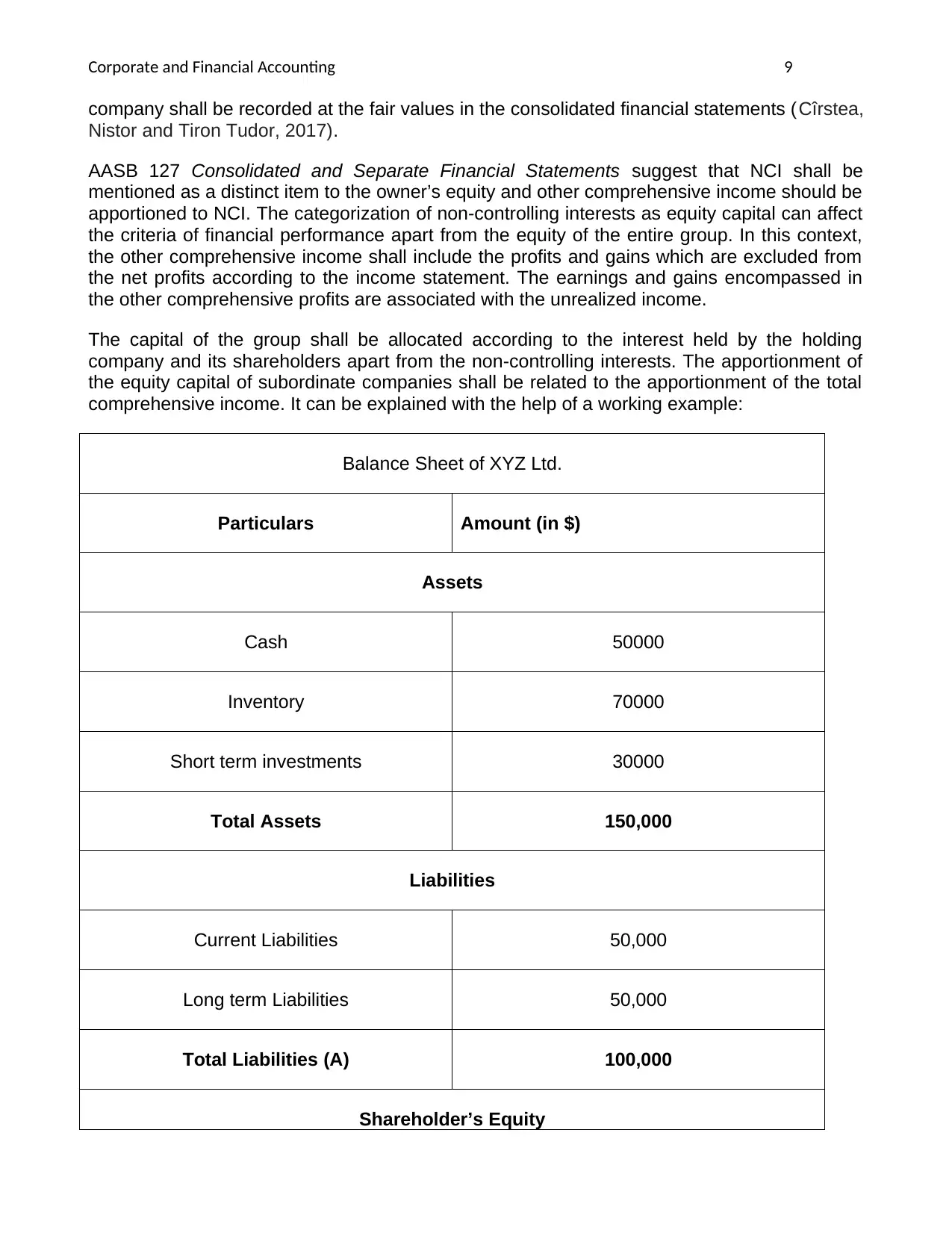
Corporate and Financial Accounting 9
company shall be recorded at the fair values in the consolidated financial statements (Cîrstea,
Nistor and Tiron Tudor, 2017).
AASB 127 Consolidated and Separate Financial Statements suggest that NCI shall be
mentioned as a distinct item to the owner’s equity and other comprehensive income should be
apportioned to NCI. The categorization of non-controlling interests as equity capital can affect
the criteria of financial performance apart from the equity of the entire group. In this context,
the other comprehensive income shall include the profits and gains which are excluded from
the net profits according to the income statement. The earnings and gains encompassed in
the other comprehensive profits are associated with the unrealized income.
The capital of the group shall be allocated according to the interest held by the holding
company and its shareholders apart from the non-controlling interests. The apportionment of
the equity capital of subordinate companies shall be related to the apportionment of the total
comprehensive income. It can be explained with the help of a working example:
Balance Sheet of XYZ Ltd.
Particulars Amount (in $)
Assets
Cash 50000
Inventory 70000
Short term investments 30000
Total Assets 150,000
Liabilities
Current Liabilities 50,000
Long term Liabilities 50,000
Total Liabilities (A) 100,000
Shareholder’s Equity
company shall be recorded at the fair values in the consolidated financial statements (Cîrstea,
Nistor and Tiron Tudor, 2017).
AASB 127 Consolidated and Separate Financial Statements suggest that NCI shall be
mentioned as a distinct item to the owner’s equity and other comprehensive income should be
apportioned to NCI. The categorization of non-controlling interests as equity capital can affect
the criteria of financial performance apart from the equity of the entire group. In this context,
the other comprehensive income shall include the profits and gains which are excluded from
the net profits according to the income statement. The earnings and gains encompassed in
the other comprehensive profits are associated with the unrealized income.
The capital of the group shall be allocated according to the interest held by the holding
company and its shareholders apart from the non-controlling interests. The apportionment of
the equity capital of subordinate companies shall be related to the apportionment of the total
comprehensive income. It can be explained with the help of a working example:
Balance Sheet of XYZ Ltd.
Particulars Amount (in $)
Assets
Cash 50000
Inventory 70000
Short term investments 30000
Total Assets 150,000
Liabilities
Current Liabilities 50,000
Long term Liabilities 50,000
Total Liabilities (A) 100,000
Shareholder’s Equity
Paraphrase This Document
Need a fresh take? Get an instant paraphrase of this document with our AI Paraphraser
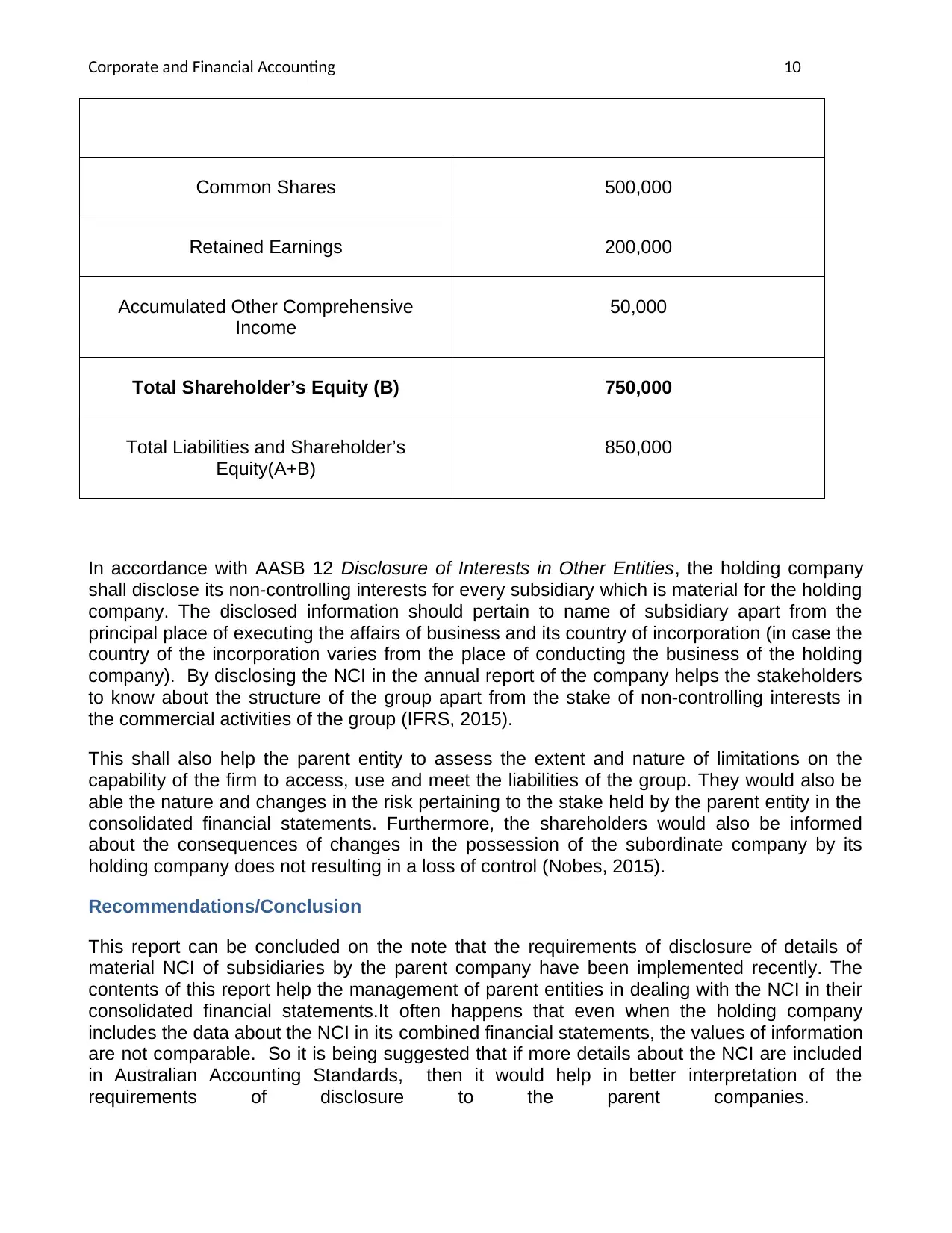
Corporate and Financial Accounting 10
Common Shares 500,000
Retained Earnings 200,000
Accumulated Other Comprehensive
Income
50,000
Total Shareholder’s Equity (B) 750,000
Total Liabilities and Shareholder’s
Equity(A+B)
850,000
In accordance with AASB 12 Disclosure of Interests in Other Entities, the holding company
shall disclose its non-controlling interests for every subsidiary which is material for the holding
company. The disclosed information should pertain to name of subsidiary apart from the
principal place of executing the affairs of business and its country of incorporation (in case the
country of the incorporation varies from the place of conducting the business of the holding
company). By disclosing the NCI in the annual report of the company helps the stakeholders
to know about the structure of the group apart from the stake of non-controlling interests in
the commercial activities of the group (IFRS, 2015).
This shall also help the parent entity to assess the extent and nature of limitations on the
capability of the firm to access, use and meet the liabilities of the group. They would also be
able the nature and changes in the risk pertaining to the stake held by the parent entity in the
consolidated financial statements. Furthermore, the shareholders would also be informed
about the consequences of changes in the possession of the subordinate company by its
holding company does not resulting in a loss of control (Nobes, 2015).
Recommendations/Conclusion
This report can be concluded on the note that the requirements of disclosure of details of
material NCI of subsidiaries by the parent company have been implemented recently. The
contents of this report help the management of parent entities in dealing with the NCI in their
consolidated financial statements.It often happens that even when the holding company
includes the data about the NCI in its combined financial statements, the values of information
are not comparable. So it is being suggested that if more details about the NCI are included
in Australian Accounting Standards, then it would help in better interpretation of the
requirements of disclosure to the parent companies.
Common Shares 500,000
Retained Earnings 200,000
Accumulated Other Comprehensive
Income
50,000
Total Shareholder’s Equity (B) 750,000
Total Liabilities and Shareholder’s
Equity(A+B)
850,000
In accordance with AASB 12 Disclosure of Interests in Other Entities, the holding company
shall disclose its non-controlling interests for every subsidiary which is material for the holding
company. The disclosed information should pertain to name of subsidiary apart from the
principal place of executing the affairs of business and its country of incorporation (in case the
country of the incorporation varies from the place of conducting the business of the holding
company). By disclosing the NCI in the annual report of the company helps the stakeholders
to know about the structure of the group apart from the stake of non-controlling interests in
the commercial activities of the group (IFRS, 2015).
This shall also help the parent entity to assess the extent and nature of limitations on the
capability of the firm to access, use and meet the liabilities of the group. They would also be
able the nature and changes in the risk pertaining to the stake held by the parent entity in the
consolidated financial statements. Furthermore, the shareholders would also be informed
about the consequences of changes in the possession of the subordinate company by its
holding company does not resulting in a loss of control (Nobes, 2015).
Recommendations/Conclusion
This report can be concluded on the note that the requirements of disclosure of details of
material NCI of subsidiaries by the parent company have been implemented recently. The
contents of this report help the management of parent entities in dealing with the NCI in their
consolidated financial statements.It often happens that even when the holding company
includes the data about the NCI in its combined financial statements, the values of information
are not comparable. So it is being suggested that if more details about the NCI are included
in Australian Accounting Standards, then it would help in better interpretation of the
requirements of disclosure to the parent companies.
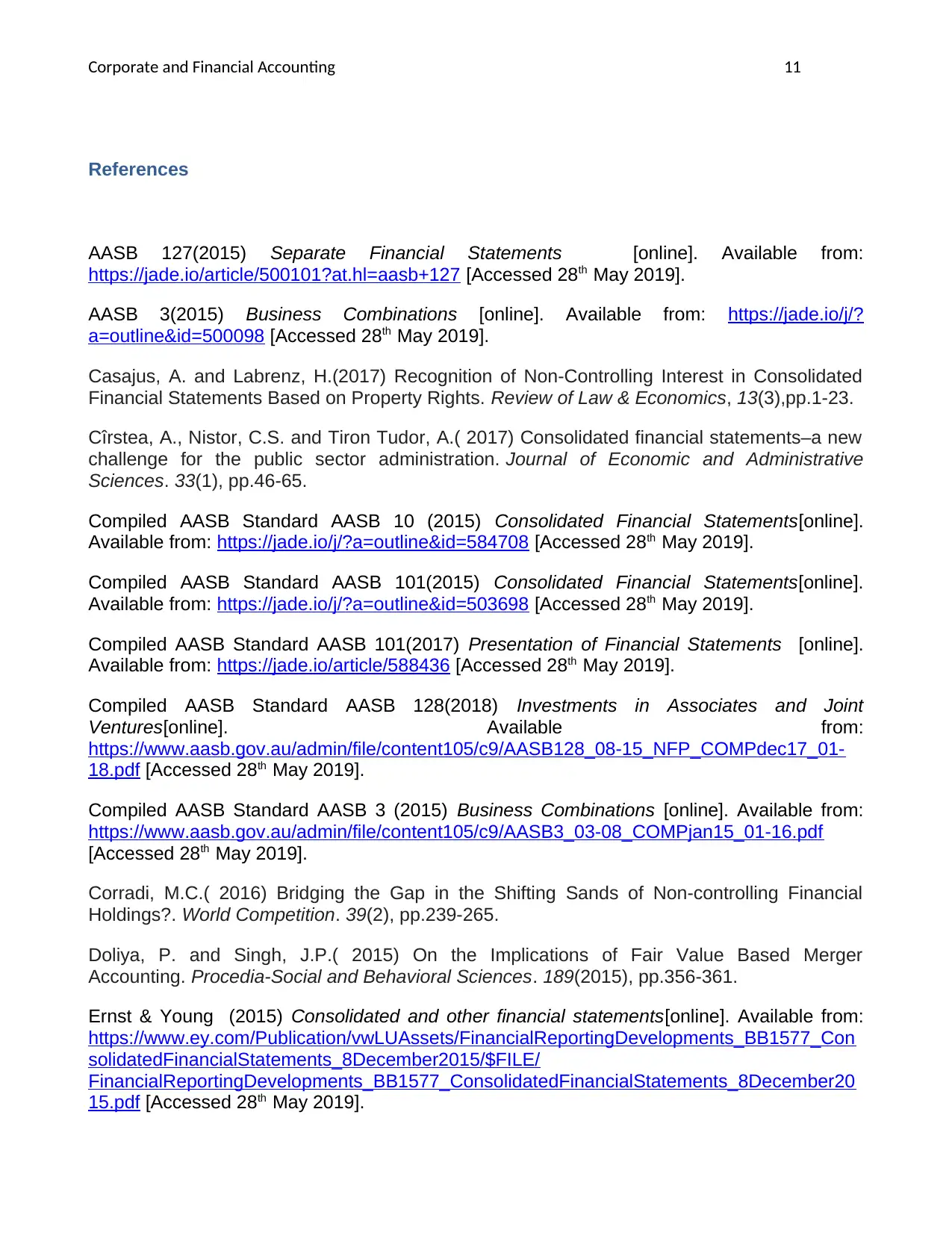
Corporate and Financial Accounting 11
References
AASB 127(2015) Separate Financial Statements [online]. Available from:
https://jade.io/article/500101?at.hl=aasb+127 [Accessed 28th May 2019].
AASB 3(2015) Business Combinations [online]. Available from: https://jade.io/j/?
a=outline&id=500098 [Accessed 28th May 2019].
Casajus, A. and Labrenz, H.(2017) Recognition of Non-Controlling Interest in Consolidated
Financial Statements Based on Property Rights. Review of Law & Economics, 13(3),pp.1-23.
Cîrstea, A., Nistor, C.S. and Tiron Tudor, A.( 2017) Consolidated financial statements–a new
challenge for the public sector administration. Journal of Economic and Administrative
Sciences. 33(1), pp.46-65.
Compiled AASB Standard AASB 10 (2015) Consolidated Financial Statements[online].
Available from: https://jade.io/j/?a=outline&id=584708 [Accessed 28th May 2019].
Compiled AASB Standard AASB 101(2015) Consolidated Financial Statements[online].
Available from: https://jade.io/j/?a=outline&id=503698 [Accessed 28th May 2019].
Compiled AASB Standard AASB 101(2017) Presentation of Financial Statements [online].
Available from: https://jade.io/article/588436 [Accessed 28th May 2019].
Compiled AASB Standard AASB 128(2018) Investments in Associates and Joint
Ventures[online]. Available from:
https://www.aasb.gov.au/admin/file/content105/c9/AASB128_08-15_NFP_COMPdec17_01-
18.pdf [Accessed 28th May 2019].
Compiled AASB Standard AASB 3 (2015) Business Combinations [online]. Available from:
https://www.aasb.gov.au/admin/file/content105/c9/AASB3_03-08_COMPjan15_01-16.pdf
[Accessed 28th May 2019].
Corradi, M.C.( 2016) Bridging the Gap in the Shifting Sands of Non-controlling Financial
Holdings?. World Competition. 39(2), pp.239-265.
Doliya, P. and Singh, J.P.( 2015) On the Implications of Fair Value Based Merger
Accounting. Procedia-Social and Behavioral Sciences. 189(2015), pp.356-361.
Ernst & Young (2015) Consolidated and other financial statements[online]. Available from:
https://www.ey.com/Publication/vwLUAssets/FinancialReportingDevelopments_BB1577_Con
solidatedFinancialStatements_8December2015/$FILE/
FinancialReportingDevelopments_BB1577_ConsolidatedFinancialStatements_8December20
15.pdf [Accessed 28th May 2019].
References
AASB 127(2015) Separate Financial Statements [online]. Available from:
https://jade.io/article/500101?at.hl=aasb+127 [Accessed 28th May 2019].
AASB 3(2015) Business Combinations [online]. Available from: https://jade.io/j/?
a=outline&id=500098 [Accessed 28th May 2019].
Casajus, A. and Labrenz, H.(2017) Recognition of Non-Controlling Interest in Consolidated
Financial Statements Based on Property Rights. Review of Law & Economics, 13(3),pp.1-23.
Cîrstea, A., Nistor, C.S. and Tiron Tudor, A.( 2017) Consolidated financial statements–a new
challenge for the public sector administration. Journal of Economic and Administrative
Sciences. 33(1), pp.46-65.
Compiled AASB Standard AASB 10 (2015) Consolidated Financial Statements[online].
Available from: https://jade.io/j/?a=outline&id=584708 [Accessed 28th May 2019].
Compiled AASB Standard AASB 101(2015) Consolidated Financial Statements[online].
Available from: https://jade.io/j/?a=outline&id=503698 [Accessed 28th May 2019].
Compiled AASB Standard AASB 101(2017) Presentation of Financial Statements [online].
Available from: https://jade.io/article/588436 [Accessed 28th May 2019].
Compiled AASB Standard AASB 128(2018) Investments in Associates and Joint
Ventures[online]. Available from:
https://www.aasb.gov.au/admin/file/content105/c9/AASB128_08-15_NFP_COMPdec17_01-
18.pdf [Accessed 28th May 2019].
Compiled AASB Standard AASB 3 (2015) Business Combinations [online]. Available from:
https://www.aasb.gov.au/admin/file/content105/c9/AASB3_03-08_COMPjan15_01-16.pdf
[Accessed 28th May 2019].
Corradi, M.C.( 2016) Bridging the Gap in the Shifting Sands of Non-controlling Financial
Holdings?. World Competition. 39(2), pp.239-265.
Doliya, P. and Singh, J.P.( 2015) On the Implications of Fair Value Based Merger
Accounting. Procedia-Social and Behavioral Sciences. 189(2015), pp.356-361.
Ernst & Young (2015) Consolidated and other financial statements[online]. Available from:
https://www.ey.com/Publication/vwLUAssets/FinancialReportingDevelopments_BB1577_Con
solidatedFinancialStatements_8December2015/$FILE/
FinancialReportingDevelopments_BB1577_ConsolidatedFinancialStatements_8December20
15.pdf [Accessed 28th May 2019].
⊘ This is a preview!⊘
Do you want full access?
Subscribe today to unlock all pages.

Trusted by 1+ million students worldwide
1 out of 13
Related Documents
Your All-in-One AI-Powered Toolkit for Academic Success.
+13062052269
info@desklib.com
Available 24*7 on WhatsApp / Email
![[object Object]](/_next/static/media/star-bottom.7253800d.svg)
Unlock your academic potential
Copyright © 2020–2025 A2Z Services. All Rights Reserved. Developed and managed by ZUCOL.





